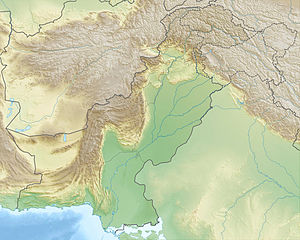Chhachh
Chhachh
چھچھ Chach | |
|---|---|
 A village of Chhach near Attock | |
| Coordinates: 33°53′00″N 72°22′00″E / 33.88333°N 72.36667°E | |
| Country | |
| Province | Punjab |
| District | Attock District |
| Tehsil | Hazro Tehsil |
| Demonym | Chhachhi |
| Time zone | UTC+5 (PST) |
| • Summer (DST) | +6 |
| Part of a series on |
| Punjabis |
|---|
 |
 Punjab portal |
Chhachh or Chach (Hindko: چھچھ) is a region located in Punjab, Pakistan between Peshawar and Islamabad at the northern tip of Attock, consisting of an alluvial plain extending from Attock District of Punjab, Pakistan, southwest of Topi and Swabi.[1] Chhachh is one of the richest region in punjab
Etymology
[edit]Chach has been identified as the Chukhsa country of Gandhara in the Taxila copper plate inscription. The area is mentioned in various epigraphic material, such as the Taxila copper plate inscription, where it is described as a territory of the Scythian ruler Liaka Kusulaka.[2]
History
[edit]Ancient History
[edit]


Chach has been identified as the Chukhsa country of the Taxila copper plate inscription.[2] The Chhachh region is located at the historical region of Gandhara Civilization, the ancient Indo-Aryan Civilization. The region was inhabited by the Indo-Scythians. Liaka Kusulaka was an Indo-Scythian satrap of the area of Chukhsa (Chach) during the 1st century BCE. Later the region was inhabited by Kabul Shahis and later was ruled by Hindu Shahis.[3] Many rulers such as Alexander the Great, Mahmud of Ghazni, Timur, Nader Shah and Babur and their armies crossed the Indus River at or about this region in their respective invasions of India.[4]
A silver jug found at Taxila indicates that Zeionises was the "satrap of Chuksa, son of Manigula, brother of the great king", but who this king was remains uncertain.[5]


Obv: King on horseback holding whip, with bow behind. Corrupted Greek legend MANNOLOU UIOU SATRAPY ZEIONISOU "Satrap Zeionises, son of Manigula". Buddhist Triratna symbol.
Rev: King on the left, receiving a crown from a city goddess holding a cornucopia. Kharoshthi legend MANIGULASA CHATRAPASA PUTRASA CHATRAPASA JIHUNIASA "Satrap Zeionises, son of Satrap Manigul". South Chach mint.
Middle Ages
[edit]The Battle of Chach was fought in 1008 AD between the Ghaznavid army of Sultan Mahmud of Ghazni and the Hindu Shahi army of Anandapala, resulting in the latter's defeat. The Gakhars became vital in the hills to the east, but their dominion never extended beyond the Margalla pass. Ghakhars were defeated by the Kashmiri ruler Sultan Shihabu’d-din near Ohind and continued under Kashmiri rule until the conquest of Babur.[6]
Early Modern Period
[edit]This section needs additional citations for verification. (November 2023) |
The Battle of Attock (also known as Battle of Chuch) took place on 13 July 1813 between the Sikh Empire and the Durrani Empire.[7] The battle was the first significant Sikh victory over the Durranis.[8]
During British Rule the region became part of Attock Tehsil; the municipality of Attock which was created in 1867 and the North-Western Railway connected the town to Lawrencepur. The town is surrounded by rich cultivation, and from 20th century had a flourishing trade, chiefly in tobacco and sugar.
Geography
[edit]Chhachh is 7 km (4 mi) off the Pindi-Peshawar GT road. Chach is at the edge of Khyber Pakhtunkhwa-Punjab border. It is 20.4 km from Attock city and 22.9 km from Topi, Khyber Pakhtunkhwa.It is bounded on the north and west by the Indus River and is about 19 miles (31 km) long (from east to west) and 9 miles (14 km) broad.[9]
Chhachh is a plain which rolls from the Hazara-Punjab hills south to Kamra, and from east of the River Indus to the broken lands near Lawrencepur.
Demography
[edit]The Chach Valley, consisting of 84 villages located along the Indus River. Percolation from the Indus makes the area extremely fertile. The region was surrounded by rich cultivation, and had a flourishing trade, chiefly in tobacco and sugar. The population of the area are primarily Hindkowans, Pashtun people of the area who hail from the Yusufzai, Barakzai, Akakhel, Tareen, Alizai, Lodi, Sadozai tribes and Kashmiris. People of this region speak Chhachi dialect of Hindko. "Chhachhi" is also a demonym for the people from Chhachh. Chhachi people are usually bilingual both in Hindko and Pashto languages. It also has a significant number of people living abroad.[10]
References
[edit]- ^ Peach, Ceri; Vertovec, Steven (27 July 2016). Islam in Europe: The Politics of Religion and Community. Springer. ISBN 9781349256976.
- ^ a b "Imperial Gazetteer2 of India, Volume 10, page 115 -- Imperial Gazetteer of India -- Digital South Asia Library". dsal.uchicago.edu. Archived from the original on 13 June 2010.
- ^ "Imperial Gazetteer2 of India, Volume 10, page 115 -- Imperial Gazetteer of India -- Digital South Asia Library". dsal.uchicago.edu.
- ^ One or more of the preceding sentences incorporates text from a publication now in the public domain: Chisholm, Hugh, ed. (1911). "Attock". Encyclopædia Britannica. Vol. 2 (11th ed.). Cambridge University Press. p. 886.
- ^ Konow, Sten (1929). Kharoshṭhī Inscriptions: with the Exception of Those of Aśoka. Kolkata: Government of India Central Publication Branch. p. 82, PLATE XVI.
- ^ Hasan, Mohibbul (2005). Kashmir Under the Sultans. Aakar Books. ISBN 978-81-87879-49-7.
- ^ Cunningham 1918, pp. 152–153
- ^ Jaques 2006, p. 81
- ^ Conference, British Dam Society (2002). Reservoirs in a Changing World: Proceedings of the 12th Conference of the BDS Held at Trinity College, Dublin, 4-8 September 2002. Thomas Telford. ISBN 9780727731395.
- ^ Beauty of Chhachh - Tribes
Sources
[edit]- Cunningham, Joseph Davey (1918). A history of the Sikhs: from the origin of the nation to the battles of the Sutlej. London, New york: Oxford University Press.
- Jaques, Tony (2006). Dictionary of Battles and Sieges: A-E. Greenwood Press. ISBN 978-0-313-33537-2.

